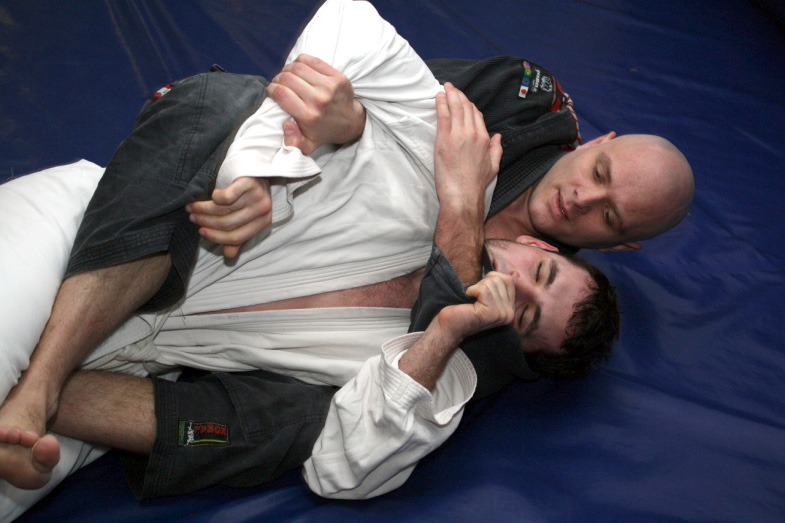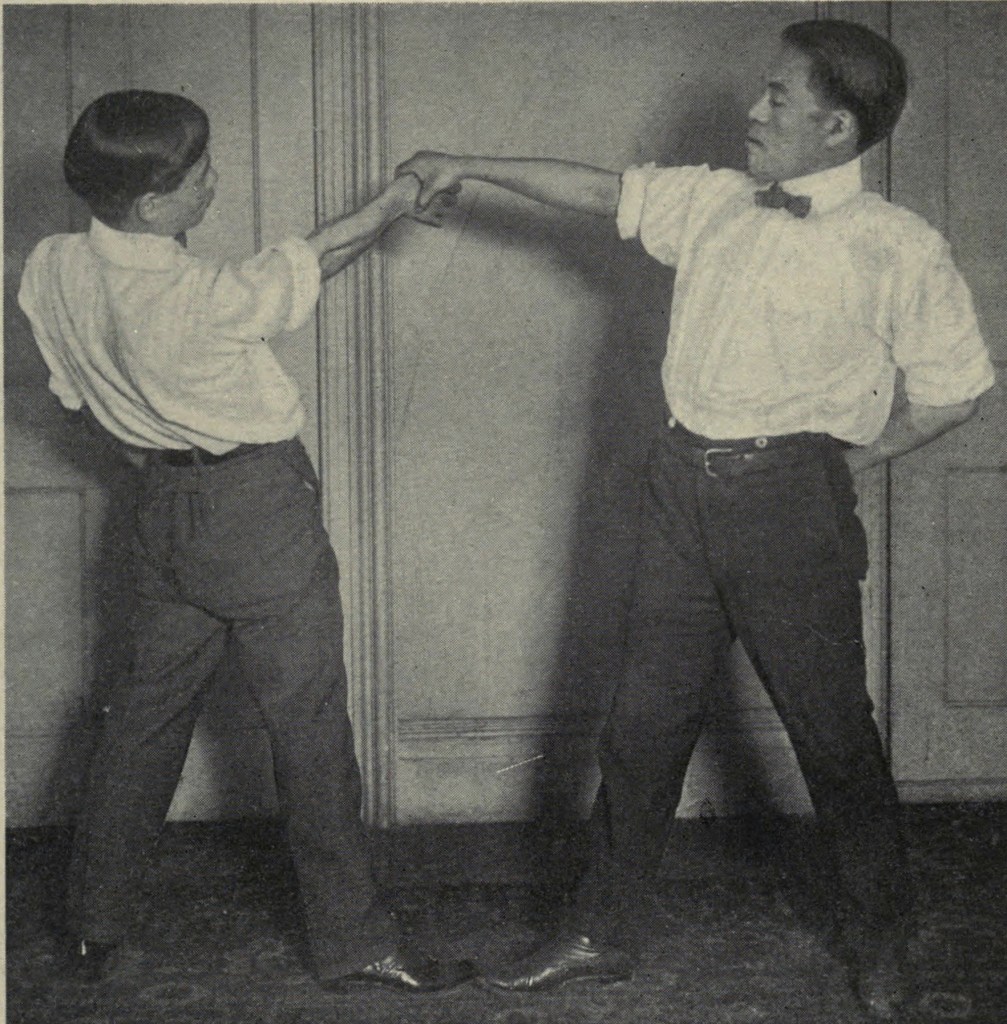My main martial arts experience is in Brazilian Jiu-Jitsu (BJJ), but I usually attend The Greatest Camp on Earth every summer. The camp is set up primarily for Judo, but it also has instructors for a few classical or Japanese Jujitsu (JJJ) styles.
My first exposure to the older systems came at one of the camps in 2014. From there, I have learned a few techniques in many styles including Tanjo-Jutsu while visiting the Bahamas in 2016 (see main photo). Throughout my martial arts journey, I have sought insights from the classical systems that might work in my BJJ training.
You’ve probably read or heard many comparisons of BJJ and JJJ, but my intention here is to make the argument that they are both still valid arts depending on what you want from them. I will also illustrate how and why they differ.
Darrell Craig, author of Japanese Jiu-Jitsu: Secret Techniques of Self-Defense, uses Webster’s to define JJJ as “The Japanese art of defending oneself by grasping or striking an opponent so that his own strength and weight are used against him.”
He also cites one of his teachers. Sensei Takahiko Ohtsuka said, “The term jiu-jitsu literally means, technique or art (that is, jitsu) of suppleness, flexibility, pliancy, or gentleness (that is, all renditions of the ideogram ju).”
The first definition Craig offers from Webster’s is more akin to the classical systems. The explanation suggested by his sensei embodies the art as a whole and also encompasses the essence of BJJ.
A revered JJJ teacher, George Kirby, writes in his book, Jujitsu: Basic Techniques of The Gentle Art, that “jujitsu is the gentle art of self-defense. This is a very simple definition of a very complicated art.”
His definition also fits both styles, the classical and the modern, because they both can be used for self-defense.
There are other key similarities between them.
Kirby notes, “the study of jujitsu requires two people who are willing to work together and trust one another. Basic to this willingness and trust is the requirement of caution and courtesy.”
Without training partners, we can’t drill our techniques. Without the trust that our training partner will stop short of applying the techniques in a devastating or even lethal manner, the arts wouldn’t still be around.
Other similarities lie in some of the techniques and applications.
Many years ago, in a Black Belt Magazine article, Stephan Kesting and Alexander Kask wrote, “both emphasize grappling over striking. Both emphasize the importance and efficiency of ground fighting. Both employ chokes, arm locks, leg locks, and other submission holds.”
But even with many similarities, the two systems diverge in overt ways.
Before we get into how, we must remember that the interpretations of all systems today are not necessarily what they were when they began.
Old versions of JJJ such as Daito-ryu aiki-jutsu, Takenouchi-ryu, and Tenjin Shinyo-ryu were closer to their original battlefield intentions. More modern styles, such as Danzan Ryu, Goshin Jujitsu, Miyama Ryu, and Small Circle Jujitsu emphasize different elements of the original systems, whether it’s particular techniques or esoteric principles.
You can see a similar phenomenon in the modern day. You may go to a BJJ school that emphasizes the sport aspects: points, guards, positions, and little striking or takedowns. Or, you can attend an academy with more focus on “Old School Jiu-Jitsu” that still teaches striking defense, closing the distance, positional dominance before submission, and little push to compete.
With the understanding of how the arts are similar and have changed over the years, let’s look at a few differences.
One thing that is clear in JJJ and even Judo schools is their use of the Japanese terminology almost exclusively. This serves two purposes:
- It keeps the arts consistent with their Japanese heritage.
- The terminology is often a better description of the technique than its English translation.
Kirby notes this in his book, Jujitsu: Intermediate Techniques of The Gentle Art. He writes that when the art came to America, some instructors wanted to teach in English. But, “higher ranking students grew to prefer the Japanese over English… as we understood more of the Japanese terminology, it seemed to make more sense and was easier to follow than the English.”
Where the Japanese and Brazilian styles truly diverge is in their original purpose and applications.
Kesting and Kask discussed how Jujitsu was the term used to describe “a number of close-quarters-combat systems developed by the samurai.”
This means a drastic difference in strategy. In BJJ, the aim is to submit your opponent or beat him on points. In the original JJJ systems, it was to win on the battlefield, usually with weapons and multiple attackers involved, all while wearing armor.
Staying with the purpose, Kesting and Kask use the example of back mount to illustrate key differences.
One of the best positions in Brazilian Jiu-Jitsu, back mount offers you many chokes and arm locks, but it’s also a great way to control your opponent in a match. In Japanese Jujitsu, it’s rarely taught because in a battle, having both of your hooks (legs) sunk in and a chest-to-back position secured leaves you little opportunity to deal with multiple attackers or your opponent’s armor.

Another technique you see in JJJ but not in BJJ is the defense against the wrist grab. Defending wrist grabs is often seen as outdated. I mean, who comes up and grabs your wrist nowadays?
But in Japanese Jujitsu, there are many ways to defend the wrist grab and use it to turn the attack on your opponent. The importance of these techniques becomes relevant when you remember that your opponent may be grabbing your hand to get your weapon or trying to hold your arm while raising his blade.

Kesting and Kask note that there is an emphasis on pressure-points in classical systems while Brazilian Jiu-Jitsu focuses more on what they call “structural attacks.” The reason for pressure points in the older system was to attack openings in armor or to get an opponent to drop his weapon.
In the modern era, there isn’t much need for this in sport or even self-defense settings. Aiming for a tiny area in a situation of duress isn’t a good use of your focus or movement. Structural attacks, though, seek to disable or manipulate your opponent into a position of compliance. The battlefield was a place for destruction, not compliance.
Kesting and Kask also discussed the differences in how the fight ends. In Brazilian Jiu-Jitsu competition, the tap stops the match. It signifies that your opponent has “lost the battle.”
But in Japanese Jujitsu, there is often a strike or two that follow a submission because on the battlefield, you wanted to be sure you changed your opponent’s behavior, i.e., leave him unfit for more fighting.
Lastly, Kesting and Kask list the training methods as one of the biggest differences in the two arts. Due to many of its techniques being extremely dangerous or even lethal, Japanese Jujitsu practitioners use kata or various combat scenarios and generally have little or no sparring.
On the other hand, Brazilian Jiu-Jitsu players drill techniques in a similar manner, but follow them up with sparring or “rolling.” This practice allows students to apply their techniques in a non-lethal and safer way.
Whichever art you choose to master, it’s easier to understand the differences when you see their purpose and intent. If you prefer the more modern BJJ style, enjoy it with a sense of respect for the older system that helped create it, whether you think it still works or not. For the traditionalists, think of BJJ as the proving ground for many of the techniques that no longer have a battlefield on which to fight.
Try a little of both. You might find nuggets of gold in both styles that will make your self-defense and your sport applications better.
Here is a video of a few of the no-grip throws/takedowns I learned at The Greatest Camp on Earth in 2016.
(There are affiliate links to the books I cited in this article.)
If you are interested in supporting the ongoing content here at The Philosophical Fighter, you can check out my shop or simply buy me a coffee. I appreciate any and all support and thank you for reading.
Pingback: Weekend Knowledge Dump- September 25, 2020 | Active Response Training
Pingback: Moving Mountains: The Meaning of Kuzushi | The Philosophical Fighter
Pingback: What is a Martial Arts Master Called? | The Philosophical Fighter
Love these articles they have the best info
LikeLiked by 1 person
Great article! Would the terms that John Danaher uses to describe positions and techniques generally match what JJJ would use for similar techniques? Example; Kazushi, sankaku, etc.
LikeLiked by 1 person
In many cases, yes. I often use Japanese terminology in my BJJ classes because it helps with the accuracy of what I am describing. For instance, if I say “gyaku juji jime,” that’s what BJJ calls a cross lapel. But if I say “nami juji jime,” that’s a version using the thumbs instead of four fingers, and it’s the normal way to do it in Judo. It’s more specific and it serves two other purposes: One, few coaches use Japanese when coaching at a competition making it easier for me to call out what to do without the other guy knowing what I’m saying; and two, my students rank in BJJ and Judo, which they have to know the Japanese and English translations for the techniques in each belt. To your question, Danaher understands the benefit of using the original terminology and I’m glad he has kept that part alive.
LikeLiked by 1 person
For a more complete understanding of Kazushi, a term Danaher uses often and one that changed my BJJ and Judo immensely, here is a recent post I wrote about what it is and how you can use it: https://thephilosophicalfighter.com/2020/09/28/meaning-of-kuzushi/
LikeLiked by 1 person
Pingback: A Jiu-Jiteiro walks into a Wrestling room… | The Philosophical Fighter
Pingback: Kano’s Vision: Judo as a Humanistic Endeavor | The Philosophical Fighter
Pingback: What is Jiu-Jitsu? | The Philosophical Fighter